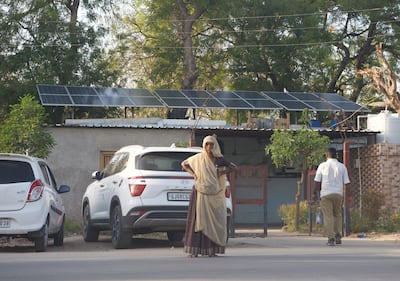
A visit to Modhera, India’s first solar-powered village
As the sun blazed over the Indian village of Modhera, Shindhi Shabnam Haagi filled bottle after bottle with water from the solar-powered electric purifier in her house.
The thirty-three year old’s family of 10, including her three young children, would need cold water that evening when they break their Ramadan fast, she said.
Until two years ago, Ms Haagi would not have been able to provide such necessities to her family. Like most of rural India, her village suffered from frequent unplanned power cuts, meaning they could not rely on electrical appliances such as the water purifier.
The power cuts were particularly bad during the summer, when demand for electricity soars up to 250 gigawatts as Indians try to keep cool with air conditioning and refrigerate their food, if they can afford to.
The installation of government-sponsored solar panels in Modhera in the western state of Gujarat has transformed life for the 1,350 families in the village, which now has round-the-clock electricity.
Gujarat, off the coast of the Arabian Sea, is one of the hottest places in the world where temperatures reach up to 50 degrees Celsius during summer.
“We have a washing machine, two ACs, ceiling fans, and a water purifier. We could not use anything because of power cuts. But with these solar power panels, we can use all the appliances,” Ms Haagi told The National.
“Earlier there were power cuts even during the night. We had to stay up all night in the heat, the children could not sleep. We can now drink cold water from the fridge in the summer and sleep in a cool room” she said.
India’s first solar-powered village
Modhera is India’s first village that runs completely on solar power, Praveen Thakur, the government representative of the village said.
It is situated around an 11th century Hindu temple dedicated to Sun, a Unesco world heritage site, that was built exactly on the Tropic of Cancer.
Most people in the village are small-scale farmers, agricultural labourers or livestock herders.
For decades, they had never experienced air conditioning or been able to cool water in sweltering temperatures.
Money and jobs lure Indians to take risky ‘donkey route’ to the West
The fortunes of the village changed in 2022 when Prime Minister Narendra Modi announced his government’s ambitious Suryagram or sun village project to provide electricity to the Sun Temple, a major tourist attraction, as well as the villagers.
The government set up a 6MW grid-connected ground-mounted solar power plant that is connected to hundreds of one-kilowatt rooftop solar panels installed on homes across the area. The project cost 800 million rupees ($9.5 million) and was partially funded by Mr Modi’s federal government and his Bharatiya Janata Party-led regional government.

The lamps and lights at the temple are lit with solar energy and a 3D light and sound show also runs on solar power every evening. The parking area outside the temple also has electric vehicle charging stations.
In the village, the once-dark streets are illuminated with solar-powered lights, and government offices and residents are receiving solar-powered electricity.
“The people who could not even use a ceiling fan are now using ACs for a fraction of the amount. For families, who are mostly labourers or farmers, it is a win-win situation,” Mr Thakur said.

Pushing renewable energy
Since coming to power, Mr Modi’s government has been pushing to harness renewable energy and has set some ambitious targets for the country such as achieving net zero by 2070.
The world’s most populous nation is under pressure to check its carbon emissions and invest in clean energy as it paces to upgrade and expand its infrastructure to meet the needs of 1.4 billion people.
It is currently the fourth largest greenhouse gas emitter after China, the US and EU. India is aiming to bring down its emissions intensity – defined as the amount of greenhouse gas emitted for every unit of GDP – to 45 per cent by 2030.
As of February 2024, renewable energy sources have a combined installed capacity of 183.49GW, according to government. This includes 45.15GW of wind power, 75.57GW of solar power, 4.99GW of small hydro power and 46.92GW of large hydro power.
In total, these non-fossil fuel sources amount to 42 per cent of India’s installed electricity capacity.
Solar energy is a major focus of the government’s strategy.
Mr Modi’s government in February approved a project with an investment of 750 billion rupees, or about $10 billion, to install rooftop solar panels and provide free electricity up to 300 units every month for 10 million households.
The scheme will provide subsidies as well as concessions on bank loans to minimise the cost burden on the people.